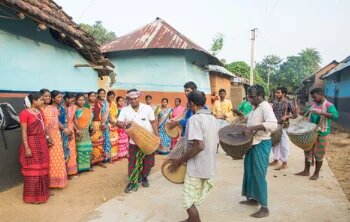


Dialogue plays a pivotal role in community media. Why? Because messages can be refined with new angles to the topics, which can improve understanding of the issues the community is facing. Hence dialogue can be used as a tool for changing social and cultural attitude. This can happen through discussion forums where people can express and exchange views.
Participation is the key feature of Community Media. This differentiates community media from traditional media models, where the audience is a passive receiver of messages. In the Community Media Model, senders and receivers together create content through active participation from both.
MANT has always taken the participatory approach in developing high-quality contents. A basic idea is creating relevant and relatable content with a social message, for the target audience, in the form of Serial Radio Dramas, Magazine Programmes and Publications.| Inception Date Of Radio Station | 2010 |
| Location Of Radio Station | Laulara, Purulia District, West Bengal |

UNICEF’S Process Documentation
MANT has been facilitating the community radio station since 2010. The radio has been broadcasting programmes in Tribal language and the first Tribal Radio Jockey in India is from our radio station. There are 10 Radio Producers along with 6 Radio Jockeys working in the radio station. The broadcasting period starts at 6 am and lasts to 9.00 pm daily. The radio has also established 50 radio listening centers in various villages managed by radio listeners’ groups. MANT has also presented the success stories in International SBCC Summits held in Addis Ababa, Ethiopia in the year 2016 and again in Bali in 2018 and in 49th World Lung Conference held in the Hague, The Netherlands in 2018. We have also published paper on success of the radio to stop child marriage. Recently UNICEF published the process documentation on the success of our radio station.
Reducing digital divide by training people particularly from marginalized communities and individuals living in media-dark areas.
The tribal people live in exclusive habitations and mostly in remote, hilly, and forest areas far from the hub of socio- political activities. Though many development initiatives, during the last 70 years in independent India, were adopted for the uplift of the tribal people the community is distinctly lagging behind in terms of accessing mass media like Radio and TV. Most of the tribal areas, hence, are being regarded as media dark areas. There is wide-spread information-poverty as the registered tribal language newspapers account for only 0.25 percent of all newspaper registrations, whereas tribal population is 8.6% of India’s total population. All India Radio Broadcast radio programmes in Santhali languages but only for 30 minutes or so while there is no TV programme in tribal languages. For many tribal languages there is no media at all. And this speaks volumes about the marginalization of tribal people in contemporary India. They are left to spend their life within the reach of their emaciating culture, shorn of its pristine glory and grandeur from a prolonged and perpetual cultural invasion from some showy sizzling cultures, and receive information through oral tradition and inter-personal communication.